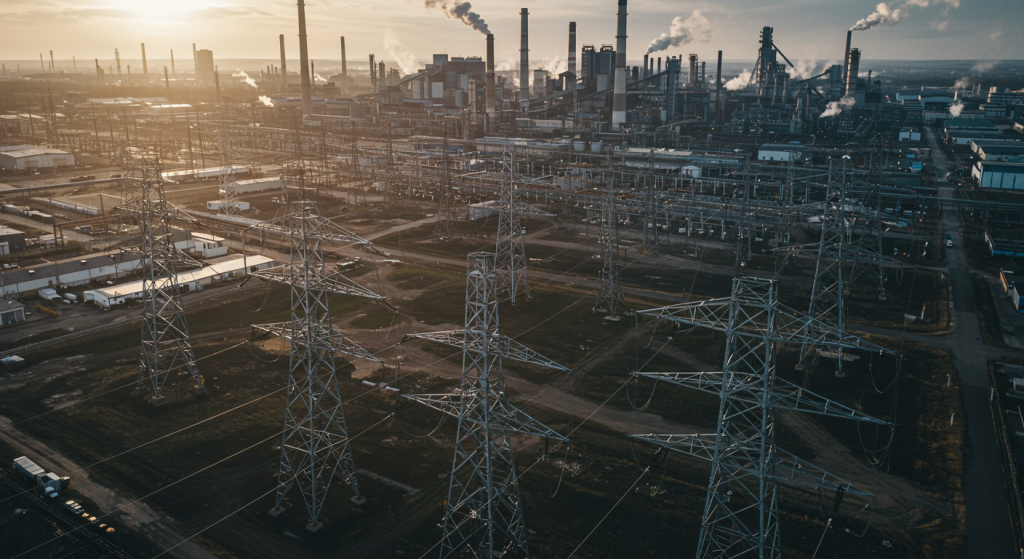10 kV to 220 kV Industrial Power Towers: How to Choose the Right
2025-07-17
Introduction
In the industrialized world today, energy transmission systems use 10 kV to 220 kV industrial power towers. Huge steel structures that carry electricity between generators and users are used for the factories, cities, and power plants to deliver electricity with accuracy and dependability. Whether it’s a manufacturing facility operation, expansion of the electric grid, a project, or transmission tower selection, accurate selection is needed to provide sufficient electricity for uninterrupted operations.
Understanding 10kV to 220 kV Power Towers
These towers are industrial power towers manufactured with steel to form frameworks that carry the overhead electrical conductors. For industrial purposes, the range of 10 kV (medium voltage) and 220 kV (high voltage) is optimal for energy transmission with minimum losses.
10 kV Transmission Structure: Found in light industries as well as in the distribution networks.
220 kV Transmission Tower: Supports heavy-duty transmission, including grid interconnections and substations linkages.
The design of these towers also incorporates other considerations such as wind load resistance, structural load capacity, conductor clearance, phase spacing, and others.
Types of Industrial Power Towers
Based on the voltage and their intended use, a wide range of configurations is available:
Steel Lattice Power Towers: These are lightweight, high-strength structures that make them fit for 220 kV lines.
• Pole Type Towers: Best suited for 10 kV to 66 kV transmission lines, these are ideal for narrow strips of land.
• H-Frame Towers: Suitable for short spans and double circuit structures.
• Guyed-V Towers: More economical for long spans.
Material & Coating Standards
To withstand tough industrial conditions and harsh environments, 10 kV to 220 kV industrial power towers are built from premium materials and use internationally certified coating methods to enhance their durability.
- The primary material used for the industrial power towers is high tensile galvanized steel, specifically Q345B and Q420 graded steels. These grades are known for their exceptional tensile strength and elevated endurance against deformation under sustained loads. Such steels are useful for the mechanical loading of overhead power lines, especially in areas prone to high winds or seismic activity.
- To combat environmental corrosion, especially in coastal or humid regions, the towers undergo hot-dip galvanization, which enhances their corrosion resistance. During this process, the steel components are immersed in molten zinc, forming a protective layer which increases the structure's durability to around many years.
Design Aspects
To design 10 kV to 220 kV industrial power towers, a combination of structural and electrical engineering is necessary to ensure safety, functionality, and longevity. Every aspect must consider the voltage, topography, and specific project requirements.
Tower Height and Span: A line's span length and a tower's height are determined by the terrain as well as the line's voltage. For higher voltages like 220kV, taller towers and greater spans between them are needed to ensure safe phase distance and minimize electromagnetic interference.
Foundation Type: The chosen foundation type must consider the local soil conditions and the weight of the tower. This selection is influenced by the soil's bearing capacity, water table, and tower height. RCC, pile, and grillage foundations are the candidates.
Wind Load Design: Compliance with IEC 60826 is a must for towers in coastal and hilly regions.

Applications in Various Industrial Sectors
Suspended transmission lines with voltage levels ranging from 10kV to 220 kV find application in various industries, including:
• Factories and Manufacturing Plants
• Power Generation Stations
• Mining Operations
• Petrochemical Complexes
• Renewable Energy Farms
• High Voltage Grid Systems
We ensure optimized power transmission by providing custom-designed towers tailored for each industry.
10 kV to 220 kV Industrial Power Towers Installation Process
This process involves distinct phases, and with each phase progresses a central evaluation is made for the necessary elements for the correct and safe power distribution electrically. It reinforces marked points for industrial towers 10KV- 220KV. Each phase is modern systems, fastening measures with precision, careful boundary restraints, and engineering decorum. Key methodologies include:
- Foundation Construction
This includes soil parameters and studying the soil profile concerning the loads to be applied. On the basis of these parameters, either RCC or pile foundations are constructed as reinforced concrete to bear the weight of the tower and wind loads.
- Tower Assembly
Depending on the challenges of the location and the structural design of the tower, some steel parts may be assembled at the ground level in substantial parts, while others at height in portions.
- Lifting
In remote areas, erection takes place through cranes, poles, and even a helicopter. The lifting part is executed with precaution and strict safety measures.
- Stringing conductors
Conductors are strung from one tower to another through the puller machines and tensioners, maintaining adequate clearance and tension to avoid sagging or breaking.
- Testing and Commissioning
Structural, electrical, and grounding integrity are verified after erection and strung in a phased manner to ensure compliance before energizing the line.
Advantages of Galvanized Steel Towers
For an industrial power tower with a voltage of 10 kV to 220 kV, galvanized steel is preferred because it offers low maintenance costs, exceptional durability, and long-term cost efficiency. The following points summarize the key advantages:
• Corrosion Resistance
The hot dip process of galvanization applies a protective zinc coat that defends the steel from rust, moisture, and even chemical corrosion. It also makes it suitable for harsh environments such as coastal, desert, or industrial zones.
• Low Upkeep
Reduced inspection and maintenance costs are attributed to infrequent repainting due to the need for less touch-up work.
• Economic Over-Extended Use
Despite somewhat elevated initial costs, long-span galvanized steel transmission lines provide long service life and low upkeep expenses, making the line economical.
• Exceptional Structural Strength
Galvanized steel retains mechanical strength due to onsite equipment and weather environmental loads for the towers, stabilizing them during severe weather events.
How to Select the Appropriate Tower (10 kV to 220 kV)
Pay attention to the following factors:
• Voltage Level: Select based on distance and load.
• Terrain Type: Hills, plains, coastal, and marine regions.
• Line Configuration: Single circuit or double.
• Span Length: Average span compared to maximum span.
• Environment: Corrosive or windy areas.
Conclusion
Beginning with 10 kV distribution towers and up to 220 kV high-voltage steel lattice structures, industrial power towers have been designed to enable stable and efficient energy transmission. The towers are built using strong materials and advanced engineering, ensuring compliance with global engineering standards, therefore, offering reliable transmission of power across long distances. Visit XY Tower today for low-cost and high-quality customized power transmission towers and their full range of services.

Hey, I’m Chunjian Shu
"X.Y. Tower: Reliable, innovative solutions for high-quality towers and electrical equipment with professional service.
